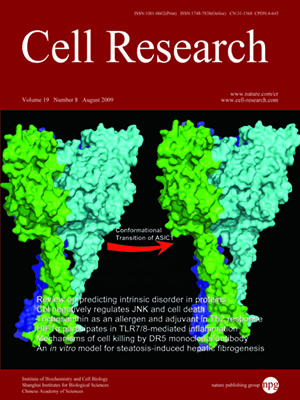
Volume 19, No 8, Aug 2009
ISSN: 1001-0602
EISSN: 1748-7838 2018
impact factor 17.848*
(Clarivate Analytics, 2019)
Volume 19 Issue 8, August 2009: 996-1005
ORIGINAL ARTICLES
Lipid accumulation in hepatocytes induces fibrogenic activation of hepatic stellate cells
Hella Wobser1,*, Christoph Dorn1,*, Thomas S Weiss2, Thomas Amann1, Cornelius Bollheimer1, Roland Büttner1, Jürgen Schölmerich1 and Claus Hellerbrand1
1Department of Internal Medicine I, University of Regensburg, D-93042 Regensburg, Germany
2Center for Liver Cell Research, Department of Surgery, University of Regensburg, D-93042 Regensburg, Germany
Correspondence: Claus Hellerbrand,(claus.hellerbrand@klinik.uni-regensburg.de )
Despite the initial belief that non-alcoholic fatty liver disease is a benign disorder, it is now recognized that fibrosis progression occurs in a significant number of patients. Furthermore, hepatic steatosis has been identified as a risk factor for the progression of hepatic fibrosis in a wide range of other liver diseases. Here, we established an in vitro model to study the effect of hepatic lipid accumulation on hepatic stellate cells (HSCs), the central mediators of liver fibrogenesis. Primary human hepatocytes were incubated with the saturated fatty acid palmitate to induce intracellular lipid accumulation. Subsequently, human HSCs were incubated with conditioned media (CM) from steatotic or control hepatocytes. Lipid accumulation in hepatocytes induced the release of factors that accelerated the activation and proliferation of HSC, and enhanced their resistance to apoptosis, largely mediated via activation of the PI-3-kinase pathway. Furthermore, CM from steatotic hepatocytes induced the expression of the profibrogenic genes TGF-β, tissue inhibitor of metallo-proteinase-1 (TIMP-1), TIMP-2 and matrix-metallo-proteinase-2, as well as nuclear-factor κB-dependent MCP-1 expression in HSC. In summary, our in vitro data indicate a potential mechanism for the pathophysiological link between hepatic steatosis and fibrogenesis in vivo. Herewith, this study provides an attractive in vitro model to study the molecular mechanisms of steatosis-induced fibrogenesis, and to identify and test novel targets for antifibrotic therapies in fatty liver disease.
Cell Research (2009) 19:996-1005. doi: 10.1038/cr.2009.73; published online 23 June 2009
FULL TEXT | PDF
Browse 1907


